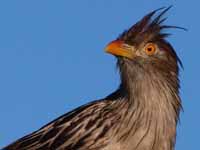The Pteroclidiformes order contains just one family, the Pteroclididae which is comprised of the sandgrouse. Sandgrouse are similar in appearance to doves and pigeons, but unlke them, the sandgrouse cannot drink without tilting their heads back
The sandgrouse are so named because most of the species are found in dry sandy areas. To help blend in with the surroundings their general color is sandy brown. They eat almost exclusively seeds. Compared to a diet of plant greens or animal based, a seed diet is dry which requires the sandgrouse have to drink lots of water. Becasue of their dry locations, that can be problematic. In the morning, large flocks of sandgrouse may fly 10 kilometers or more to a wtering hole, and some species make that round trip twice a day. As a rsult, ths andgrouse have evolved to be fast flyers. The male brings water to the chicks by absorbing it in his breast feathers that are adapted for that purpose. To wet the breast feathers he wades into the water or lies in it.
Genus Pterocles
Sandgrouse,_Black-bellied Pterocles orientalis
Description: The male black-bellied sandgrouse has golden-brown upperparts with darker markings. It has a gray head, neck, and breast. There is a chestnut throat patch, thin black breast band, and black belly. The female has browner and more finely marked upperparts. Those fine markings are on the neck and breast also. She also has a black belly. The white underwings and black belly make it easy to identify while in flight. They are sociable and flocks fly to waterholes early in the morning; again at dusk when hot. The nest is a ground scrape where both sexes incubate about 3 eggs. The black-bellied sandgrouse is 33 to 39 cm long.
Range: Spain, northwest Afica, south-west Asia.
Habitat: Dry open plains with some vegetation.
Diet: Seeds.
Conservation status: Least Concern.
Image by: 1) Joaquim_Coelho 2, 3) Jan_Svetlik 4) Sergey_YeliseevRange: Spain, northwest Afica, south-west Asia.
Habitat: Dry open plains with some vegetation.
Diet: Seeds.
Conservation status: Least Concern.
1, 2) Female 3, 4) Male


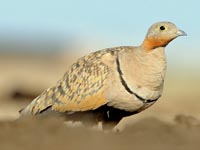

Sandgrouse,_Black-faced Pterocles decoratus
Description: The black-faced sandgrouse has a brown crown and nape with black mottling. He has a wide black forehead, with white above it. There is a thin black supercilium with a wider white border above; and there is a yellow eye-ring. His brown throat has a black center-line at the top. The upper-breast is brown, then there is a thin black breast-band, followed by a white lower-breast. His belly is black. The female lacks black on the forehead or above her white supercilium.
Range: Ethiopia, Kenya, Somalia, Tanzania, Uganda.
Habitat: Dry savanna, desert scrub.
Diet: Seeds.
Conservation status: Least Concern.
Image by: 1) Bob- Tanzania 2, 3) Nik_Borrow - Kenya, Kenya, Tsnzania 4) Dave_Curtis - KenyaRange: Ethiopia, Kenya, Somalia, Tanzania, Uganda.
Habitat: Dry savanna, desert scrub.
Diet: Seeds.
Conservation status: Least Concern.
1) Pair - female on left 2) Female 3 - 6) Male
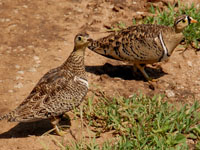



Sandgrouse,_Burchell's Pterocles burchelli
Description: The Burchell's sandgrouse has mainly reddish-brown plumage mottled with darker shades and light spots. It has pale gray cheeks and throat. The eye is surrounded by bare yellow skin. The Burchell's sandgrouse is about 25 cm long. The nest is a concealed shallow depression lined with a little dry vegetation. Both parents incubate the eggs and care for the young.
Range: Southern Africa.
Habitat: Arid areas with grass and scrub.
Diet: Seeds.
Conservation status: Least Concern.
Image by: 1) Charlie Westerinen - Zimbabwae 2) Francesco_Veronesi 3) Derek Keats - South Africa 4) Ian_White - South AfricaRange: Southern Africa.
Habitat: Arid areas with grass and scrub.
Diet: Seeds.
Conservation status: Least Concern.




Sandgrouse,_Chestnut-bellied Pterocles exustus
Description: The male chestnut-bellied sandgrouse has mainly yellowish-brown plumage. It has a thin black breast-band and a chestnut belly. The female also has mainly sandy-brown plumage but with black bars and mottling on the upperparts and just mottling on the neck. She has a blackish belly. They may travel up to 80 km per day in search of water. The chestnut-bellied sandgrouse is about 32 cm long.
Range: Central and eastern Africa; Indian Sub-Continent and westward.
Habitat: Barren semi-desert. Also arid fields and grasslands.
Diet: Seeds; also emerging vegetation and insects..
Conservation status: Least Concern.
Image by: 1, 3) Nik_Borrow - Somaliland, Tanzania 2) Shashank_shekhar29 4) Daniel_Columbo - TanzaniaRange: Central and eastern Africa; Indian Sub-Continent and westward.
Habitat: Barren semi-desert. Also arid fields and grasslands.
Diet: Seeds; also emerging vegetation and insects..
Conservation status: Least Concern.
1) Pair - female in background 2) Female 3, 4) Male




Sandgrouse,_Crowned Pterocles coronatus
Description: The crowned sandgrouse has mainly sandy-brown plumage with the upperparts mottled. The male has a black band around the bill; female lacks this black. Their face and part of the neck is orange. It is about 28 cm long. The crowned sandgrouse has entirely dark flight feathers, while the similar spotted sandgrouse does not.
Range: Northern Africa, southwest Asia.
Habitat:Prefers stony deserts over sandy deserts.
Diet: Seeds
Conservation status: Least Concern.
Image by: 1) Totodu74 2) Marcel_Holyoak - Saudi Arabia Francesco_Veronesi - Morocco Saeed Davari - IranRange: Northern Africa, southwest Asia.
Habitat:Prefers stony deserts over sandy deserts.
Diet: Seeds
Conservation status: Least Concern.

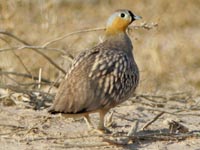


Sandgrouse,_Double-banded Pterocles bicinctus
Description: The double-banded sandgrouse has light brown plumage with darker mottling and rows of white specks. The male has a chestnut breast with a black and white band on the forehead and also black and white breast-band.
Range: Southern Africa.
Habitat: Near desert areas, woodlands, treed savanna, areas with short grass.
Diet: Seeds.
Conservation status: Least Concern.
Image by: 1) Yathin_Krishnappa 2) Bernard_Dupont 3) Arno Meintjes 4) Marie de CarneRange: Southern Africa.
Habitat: Near desert areas, woodlands, treed savanna, areas with short grass.
Diet: Seeds.
Conservation status: Least Concern.
1, 2) Female 3, 4) Male
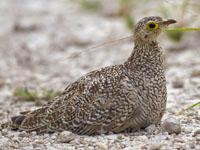



Sandgrouse,_Four-banded Pterocles quadricinctus
Description: The four-banded sandgrouse has yellowish-green upperparts, head, and neck. The back is heavily marked with brown. The male has black and white bands on his forehead plus black and white breast-bands separated from his heavily barred belly. The female lacks the head and breast bands. She has a heavily barred back and flanks.
Range: Central Africa.
Habitat: Savanna, brush lands, arid deserts.
Diet: Seeds.
Conservation status: Least Concern.
Image by: 1, 2) Charles_J_Sharp - Gambia 3) Nik_Borrow - Ghana 4) Steve_Garvie - GambiaRange: Central Africa.
Habitat: Savanna, brush lands, arid deserts.
Diet: Seeds.
Conservation status: Least Concern.
1) Pair 2) Female 3, 4) Male




Sandgrouse,_Lichtenstein's Pterocles lichtensteinii
Description: The male Lichtenstein's sandgrouse has sandy-brown plumage with his upperparts heavily covered with black vermiculation and barring. He has a black-and-white barred patten on the forehead. The breast is sandy-brown with a black breast band and the belly has dense black barring. The female is similar to the male with no black-and-white pattern on the head, no breast-band, and heavy barring on the breast. The Lichtenstein's sandgrouse is up to 26 cm long,
Range: Central Asia and southwest Asia.
Habitat: Arid areas such as desert and scrubland.
Diet: Mainly seeds, also insects.
Conservation status: Least Concern.
Image by: 1. 2, 3) Nik_Borrow 4) Carol Foil - KenyaRange: Central Asia and southwest Asia.
Habitat: Arid areas such as desert and scrubland.
Diet: Mainly seeds, also insects.
Conservation status: Least Concern.




Sandgrouse,_Madagascar Pterocles personatus
Description: The male Madagascar sandgrouse has brownish plumage. He has a mottled back and three dark wing bars. There is black at and around the base of bill plus a yellow eye-ring. The cheeks, sides of neck and upper breast are pinkish buff, fading to white on the chin and throat. The lower-breast and belly are barred.The female is brown with dark specks and bars; no black on the face. The Madagascar sandgrouse is the only sandgrouse on the island. It is about 35 cm long.
Range: Madagascar.
Habitat: Grassy open areas.
Diet: Seeds.
Conservation status: Least Concern.
Image by: 1) John Gerrard Keulemans 2) David Cook 3) Zak_PohlenRange: Madagascar.
Habitat: Grassy open areas.
Diet: Seeds.
Conservation status: Least Concern.
1) Pair 2,3) Male
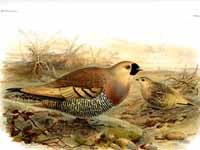

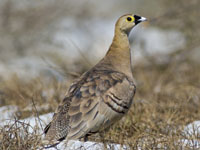
Sandgrouse,_Namaqu Pterocles namaqua
Description: The Namaqu sandgrouse has brown upperparts with large (male) or small (female) white spots. The male has an orange-buff head and breast. The breast has a brown and white double breast band.The Namaqu sandgrouse is about 28 cm long.
Range: South and west Africa.
Habitat: Arid open areas with grasses; also treed savanna.
Diet: Seeds
Conservation status: Least Concern.
Image by: 1, 4) Nik_Borrow - Nambia 2)_Frans_Vandewalle 3) Arno Meintjes Range: South and west Africa.
Habitat: Arid open areas with grasses; also treed savanna.
Diet: Seeds
Conservation status: Least Concern.
1, 2) Female 3, 4) Male




Sandgrouse,_Painted Pterocles indicus
Description: The male painted sandgrouse has brown upperparts with bold black and white bars. He has a black bar across a white forehead, fine black bars on his nape, and a white eye-ring. The breast is pinkish-brown with broad black and white breast bands. His bill is orange. The female is duller grayish-brown barred and speckled darker brown and white.
Range: India, Pakistan.
Habitat: Dry regions in rough grassland, rocky areas and scrub.
Diet: Mainly seeds.
Conservation status: Least Concern.
Image by: 1) Bernard_Dupont 2) Rudraksha_Chodankar 3) Koshy_Koshy 3) Srihari_Kulkarni Range: India, Pakistan.
Habitat: Dry regions in rough grassland, rocky areas and scrub.
Diet: Mainly seeds.
Conservation status: Least Concern.
1, 2) Female 3, 4) Male
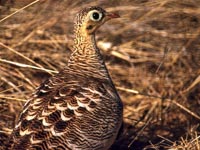

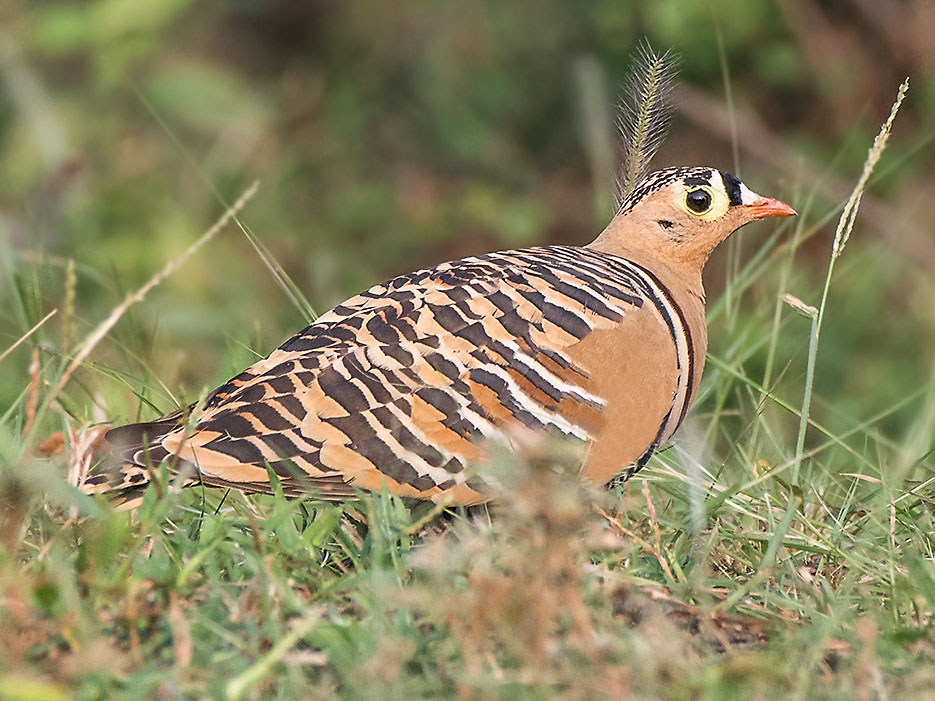
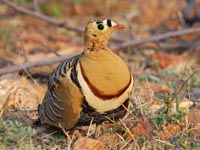
Sandgrouse,_Pin-tailed Pterocles alchata
Description: The pin-tailed sandgrouse's tail has a long thin extension, hence the name "pin-tailed". The tail length varies greatly (female's shorter) which results in a variation of the bird's length form 31 to 39 cm. Both sexes have a chestnut breast bordered above and below by a black breast-band. And they both have a black eye-line, with the male's bolder in breeding time. The female has a white throat and in breeding season, the male has a black throat. The plumage variation during breeding season is an abnormally for sandgrouse.
Range: Northern Africa, southern Europe, Asia.
Habitat: Stony land, edges of desert..
Diet: Seed; also small invertebrates.
Conservation status: Least Concern.
bImage by: 1, 2, 3) Francesco_Veronesi - Spain 4) AESRange: Northern Africa, southern Europe, Asia.
Habitat: Stony land, edges of desert..
Diet: Seed; also small invertebrates.
Conservation status: Least Concern.




Sandgrouse,_Spotted Pterocles senegallus Found: Africa
Description: The male spotted sandgrouse has pinkish-gray upperparts with dark patches on the wings. He has an orange face. His breast is unspotted grey and has no breast-band. The similar female has dense black spotting on her crown and breast. The spotted sandgrouse is about 33 cm long.
Range: Northern Africa continuing to western Asia.
Habitat: Sparsely vegetated desert and semi-desert..
Diet: Seeds.
Conservation status: Least Concern.
Image by: 1) Vil_Sandi 2) Ron_Knight 3) Mike_PenceRange: Northern Africa continuing to western Asia.
Habitat: Sparsely vegetated desert and semi-desert..
Diet: Seeds.
Conservation status: Least Concern.
1) Pair 2) Female 3) Males

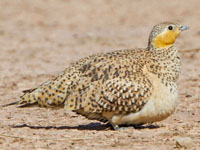

Sandgrouse,_Yellow-throated Pterocles gutturalis
Description: The male yellow-throated sandgrouse has yellowish-buff supercilium, face, and throat. He has a thin dark line from the eye to lores and a black border to the throat that is thinest at its bottom. The female has a plain face and much heavier mottling than the male.
Range: Eastern Africa.
Habitat: Short grass, plowed land.
Diet: Seeds.
Conservation status: Least Concern.
Image by: 1) Tarique_Sani 2, 3, 4) Nik_Borrow - TanzaniaRange: Eastern Africa.
Habitat: Short grass, plowed land.
Diet: Seeds.
Conservation status: Least Concern.
1, 2) Pair 3) Female 4) Male




Genus Syrrhaptes
Sandgrouse,_Pallas's Syrrhaptes paradoxus Found: Asia
Description: The Pallas's sandgrouse has sandy brown plumage. The upperparts have black marks and an orange face. The orange is more pronounce on the male. The female also has black marks on her breast and the male has a faint breast-band comprised of a series of thin lines. They both have a black belly patch. They have long thin tail extensions which causes their length to vary from 30 to 40 cm.
Range: Central Asia.
Habitat: Semi-desert ranging in altitude to 3000 m.
Diet: Seeds, new plant growth.
Conservation status: Least Concern.
Image by: 1) Sergey_Pisarevskiy - south Siberia 2) Sergey_Yeliseev 3) Jan_Svetlik 4) Tomju48Range: Central Asia.
Habitat: Semi-desert ranging in altitude to 3000 m.
Diet: Seeds, new plant growth.
Conservation status: Least Concern.
1, 2) Female 3, 4) Male
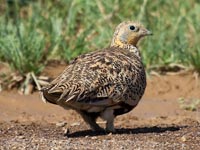



Sandgrouse,_Tibetan Syrrhaptes tibetanus
Description: The Tibetan sandgrouse has buff upperparts. The wing coverts are buff with black spots and black flight feathers. It has a pin tail. The female's back has some fine barring. They have a finely barred grey crown and orange face. The nape and breast are also gray.
Range: Mountain ranges of Asia.
Habitat: Sandy plains near water.
Diet: Seeds, new vegetation.
Conservation status: Least Concern.
Image by: 1) Dibyendu_Ash 2) Kulbhushansingh_Suryawanshi 3) Soumyajit_nandyRange: Mountain ranges of Asia.
Habitat: Sandy plains near water.
Diet: Seeds, new vegetation.
Conservation status: Least Concern.
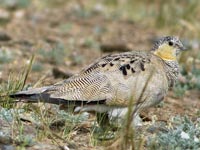


HOATZIN
Order Opisthocomiformes Family Opisthocomidae- 1 family
Order Opisthocomiformes Family Opisthocomidae- 1 family
There is much confusion about where to place the Hoatzin. Many "closest relatives" have been suggested, but all seem to be either only distantly related, or suggested due to faulty data. Perhaps the sandgrouse are the closest relatives.
Genus Opisthocomus - 1 species
Hoatzin Opisthocomus hoazin
Description: The hoatzin has dark brown upperparts with edges to the feathers. The mantle and nape have bold white edges on the feathers. There is blue orbital skin around the eyes. It has buff underparts. The hoatzin at up to 65 cm long is much larger than a sandgrouse, instead about the size of a pheasant. It is slow to flush allowing people to get relatively close before flying.
Range: Northern South America.
Habitat: Marshes and other wet lowlands.
Diet: Leaves.
Conservation status: Least Concern.
Image by: 1) Bhardwaj Shanthanu - Buenos Aires, Argentina 2) Linda
De Volder at the Beni River, Bolivia
3) Cláudio Timm - the Amazon, Brazil 4) David Cook - Sacha Lodge, Ecuador 5. 6) Nick Athanas - EcuadorRange: Northern South America.
Habitat: Marshes and other wet lowlands.
Diet: Leaves.
Conservation status: Least Concern.
